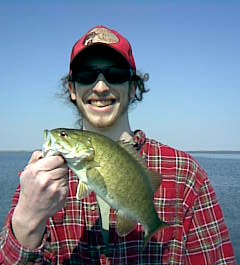Micropterus dolomieui
Lacepède, 1802
Smallmouth Bass
Also Known As: Bronzeback

Above: A Smallmouth caught from Lasalle Lake by Sam Borstein. Photo by Chris Mural.
Etymology:
Genus- Micropterus= Short Fin (Greek).
Species- dolomieui= Named after a French mineralogist.
Intro:
The Smallmouth Bass is one of Americas most popular, if not the most popular game fish. Although they don't grow as large as their relatives the Largemouth Bass, Smallmouth have the same, if not more fight in them.
This fish is not actually a true Bass, but a member of the Sunfish family. The true Bass are fish like the White Bass and Striped Bass.
Habitat:
Smallmouth Bass occur in cooler water lakes, rivers, and streams. They are often associated with currents and take shelter around sunken boulders and logs.
Spawning:
Smallmouth Bass spawn in from May-June. Their trigger is usually when the water temps hit 55-60 °F.
Diet:
Smallmouths feed on insects, frogs, and small fish. Crayfish are the preferred diet of Smallmouth Bass.
Size:
Smallmouth usually weigh 1-2 pounds, and 12-15 inches. The largest Smallmouth caught was 11 lbs. 13 oz.
Keeping In Aquaria:
Breeding is not possible in aquaria, but juveniles can be kept in large tanks on a diet of minnows and worms.
Gaming Qualities:
Smallmouth are great fighters, I believe they are better fighters than Largemouth. They will definitely run harder than a Largemouth. They occasionally will jump.
Fishing Tips:
I use 10-12 lb. test for most of my Bass rods. I love Texas rigging senko worms or wacky rigging them. Tubes work as well. On the fly rod, I like to use various streamers and foam poppers.
